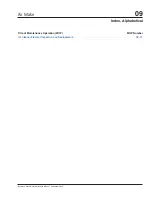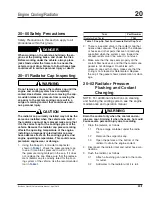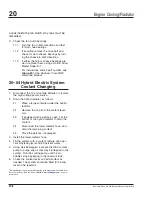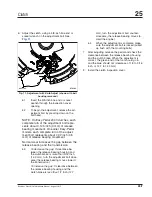
20–00 Safety Precautions
Safety Precautions in this section apply to all
procedures within this group.
DANGER
When working on the vehicle, shut down the en-
gine, set the parking brake, and chock the tires.
Before working under the vehicle, always place
jack stands under the frame rails to ensure the
vehicle cannot drop. Failure to follow these steps
could result in serious personal injury or death.
20–01 Radiator Cap Inspecting
WARNING
Do not remove or loosen the radiator cap until the
engine and cooling system have completely
cooled. Use extreme care when removing the cap.
A sudden release of pressure from removing the
cap prior to the system cooling can result in a
surge of scalding coolant that could cause seri-
ous personal injury.
CAUTION
The radiator cap currently installed may not be the
same one installed when the vehicle was built. If
the radiator cap must be replaced, make sure that
it is the correct cap for the cooling system of the
vehicle. Because the radiator cap pressure rating
affects the operating temperature of the engine,
installing an improperly rated radiator cap may
have adverse effects on the cooling system, and
engine operating temperatures. This could cause
premature engine wear or damage.
1.
Using the Snap-On tool radiator-cap tester
shown in
, check the pressure relief cap
to see if it maintains pressure to within 10% of
the pressure rating marked on the cap. If it does
not, replace the cap. Make sure that the replace-
ment radiator cap is correctly rated for the cool-
ing system of the vehicle. Use the recommended
tool in
Tool
Part Number
Radiator-Cap Tester
TA53
Table 1, Snap-On Tool For Pressure Relief Cap Test
2.
There is a second valve in the radiator cap that
opens under vacuum. This prevents the collapse
of hoses and other parts that are not internally
supported when the system cools. Inspect the
vacuum-relief valve to be sure it is not stuck.
3.
Make sure that the cap seals properly on the
coolant filler neck seat, and that the radiator cap
gasket is not damaged. On vehicles with
screw-on caps with O-rings, make sure that the
O-ring is not cracked or deteriorated. Replace
the cap if the gasket shows deterioration or dam-
age.
20–02 Radiator Pressure
Flushing and Coolant
Changing
NOTE: For additional instructions on cleaning
and flushing the cooling system, see the engine
maintenance and operation manual.
WARNING
Drain the coolant only when the coolant and en-
gine are cool. Draining it when these are hot could
cause severe personal injury due to scalding.
1.
Drain the radiator, as follows.
1.1
Place a large container under the radia-
tor.
1.2
Remove the surge tank cap.
1.3
Open the petcock at the bottom of the
radiator to drain the engine coolant.
2.
Disconnect the radiator inlet and outlet hose con-
nections.
3.
Flush the radiator, as follows.
3.1
Attach a flushing gun nozzle to the radia-
tor outlet.
3.2
Add water to the radiator until it is full.
Engine Cooling/Radiator
20
Business Class M2 Maintenance Manual, April 2019
20/1
Summary of Contents for BUSINESS CLASS M2 100
Page 2: ......
Page 10: ......
Page 30: ......
Page 34: ......
Page 36: ......
Page 38: ......
Page 40: ......
Page 42: ......
Page 46: ......
Page 52: ......
Page 60: ......
Page 62: ......
Page 76: ......
Page 82: ......
Page 84: ......
Page 94: ......
Page 104: ......
Page 110: ......
Page 112: ......
Page 114: ......
Page 116: ......
Page 120: ......
Page 122: ......
Page 144: ......
Page 146: ......
Page 150: ......
Page 152: ......
Page 166: ......
Page 168: ......
Page 178: ......
Page 180: ......
Page 184: ......
Page 186: ......
Page 188: ......
Page 190: ......
Page 192: ......
Page 196: ......
Page 198: ......









































